seats MERCEDES-BENZ E-CLASS COUPE 2009 Owners Manual
[x] Cancel search | Manufacturer: MERCEDES-BENZ, Model Year: 2009, Model line: E-CLASS COUPE, Model: MERCEDES-BENZ E-CLASS COUPE 2009Pages: 313, PDF Size: 7.76 MB
Page 44 of 313
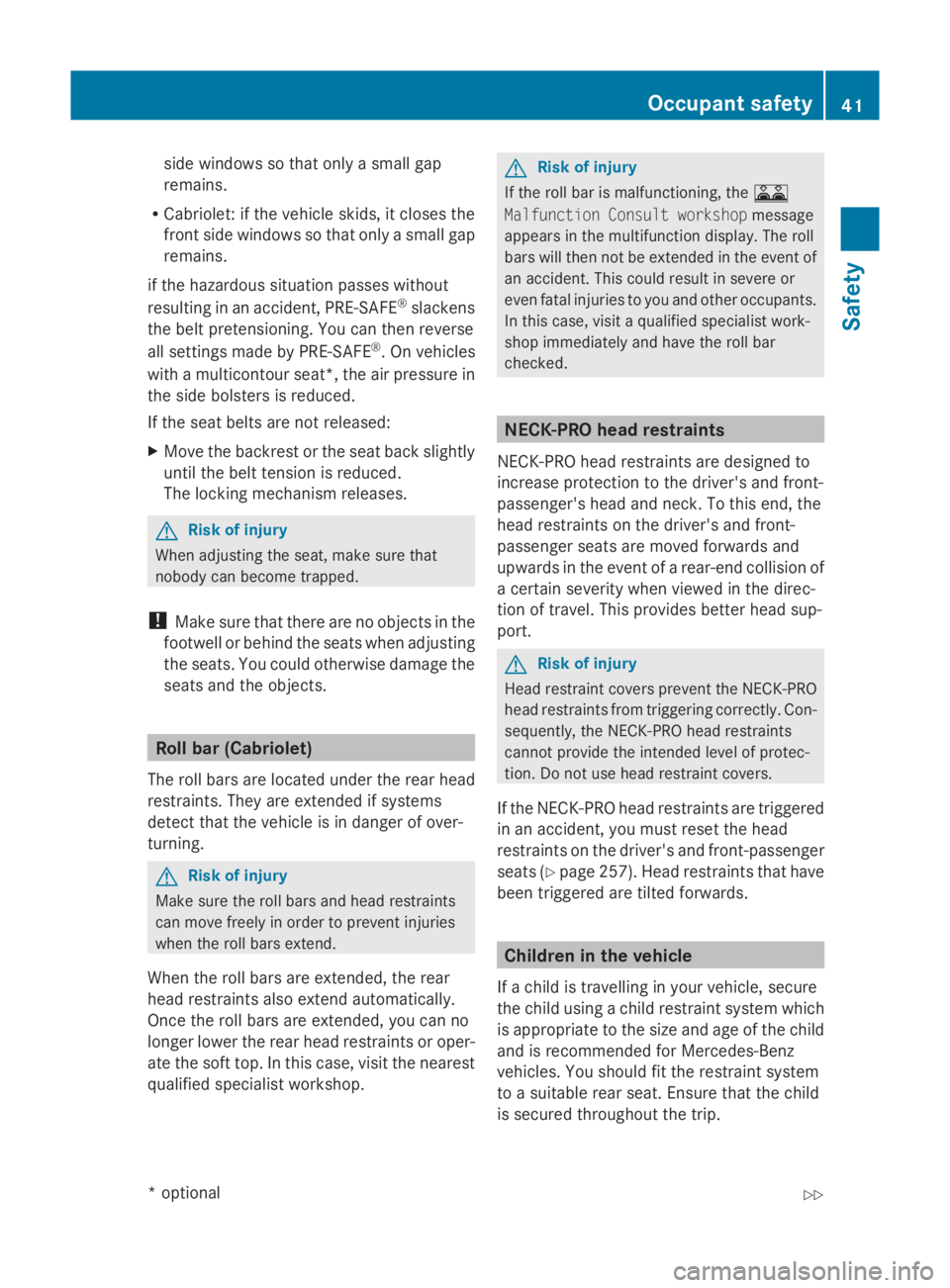
side windows so that only
asmall gap
remains.
R Cabriolet: if the vehicle skids, it closes the
front side windows so that only asmall gap
remains.
if the hazardous situation passes without
resulting in an accident, PRE-SAFE ®
slackens
the belt pretensioning. You can then reverse
all settings made by PRE-SAFE ®
.Onv ehicles
with amulticontour seat*, the air pressure in
the side bolsters is reduced.
If the seat belts are not released:
X Move the backrest or the seat back slightly
until the belt tension is reduced.
The locking mechanism releases. G
Risk of injury
When adjusting the seat, make sure that
nobody can become trapped.
! Make sure that there are no objects in the
footwell or behind the seats when adjusting
the seats. You could otherwise damage the
seats and the objects. Roll bar (Cabriolet)
The roll bars are located under the rear head
restraints. They are extended if systems
detect that the vehicle is in danger of over-
turning. G
Risk of injury
Make sure the roll bars and head restraints
can move freely in order to prevent injuries
when the roll bars extend.
When the roll bars are extended, the rear
head restraints also extend automatically.
Once the roll bars are extended, you can no
longer lower the rear head restraints or oper-
ate the soft top. In this case, visit the nearest
qualified specialist workshop. G
Risk of injury
If the roll bar is malfunctioning, the 0073
Malfunction Consult workshop message
appears in the multifunction display. The roll
bars will then not be extended in the event of
an accident. This could result in severe or
even fatal injuries to you and other occupants.
In this case, visit aqualified specialist work-
shop immediately and have the roll bar
checked. NECK-PRO head restraints
NECK-PRO head restraints are designed to
increase protection to the driver's and front-
passenger's head and neck.Tot his end, the
head restraints on the driver's and front-
passenger seats are moved forwards and
upwards in the event of arear-end collision of
ac ertain severity when viewed in the direc-
tion of travel. This provides better head sup-
port. G
Risk of injury
Head restraint covers prevent the NECK-PRO
head restraints from triggering correctly. Con-
sequently, the NECK-PRO head restraints
cannot provide the intended level of protec-
tion. Do not use head restraint covers.
If the NECK-PRO head restraints are triggered
in an accident, you must reset the head
restraints on the driver's and front-passenger
seats (Y page 257). Head restraints that have
been triggered are tilted forwards. Children in the vehicle
If ac hild is travelling in your vehicle, secure
the child using achild restraint system which
is appropriate to the size and age of the child
and is recommended for Mercedes-Benz
vehicles. You should fit the restraint system
to as uitabler ear seat. Ensure that the child
is secured throughout the trip. Occupant safety
41Safety
*optional
207_AKB;2;3,e
n-GB
mkalafa, Version: 2.11.8.1 2009-07-23T10:23:49+02:00-Seite 41 Z
Page 46 of 313
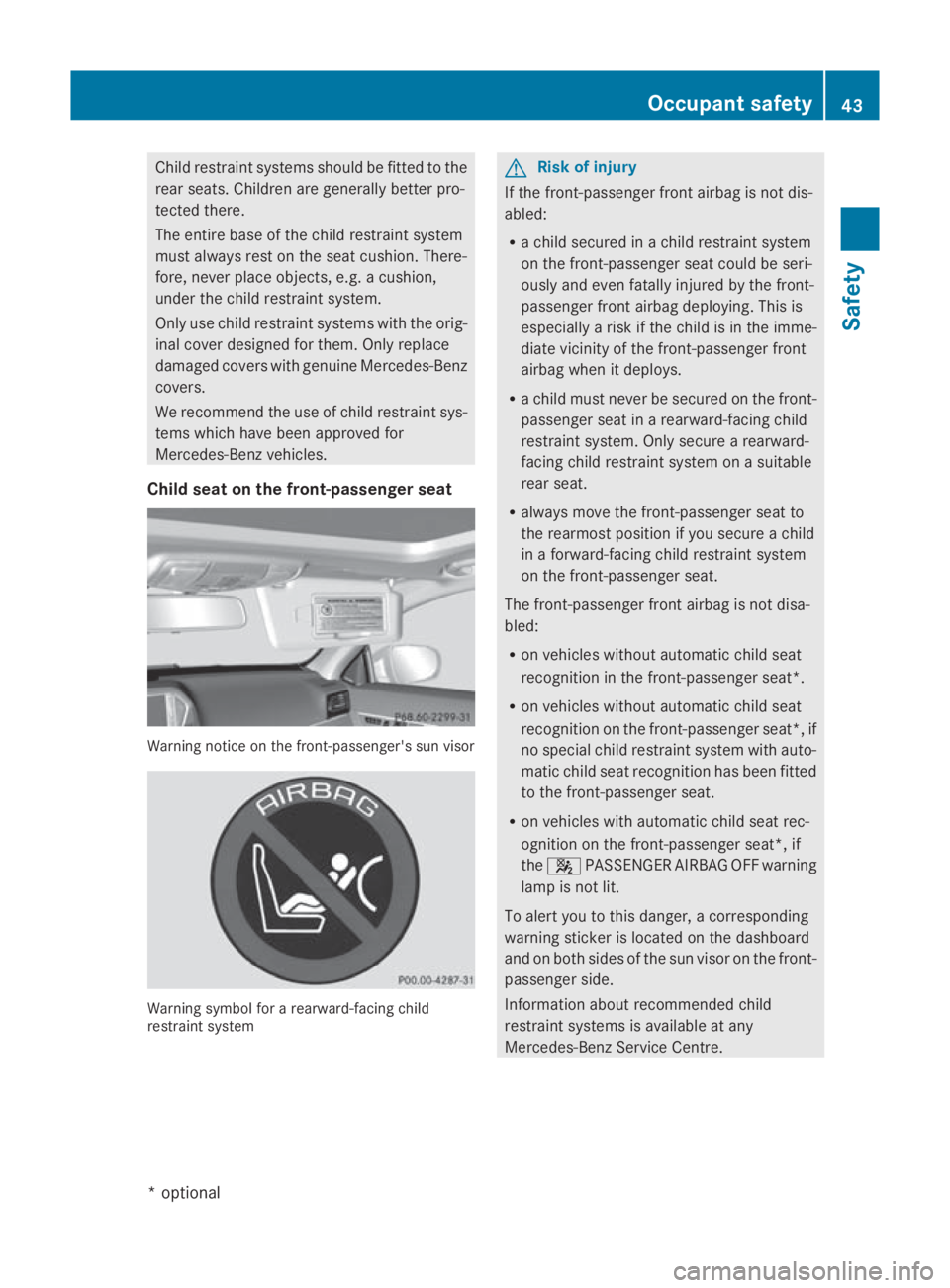
Child restraint systems should be fitte
dtothe
rear seats. Children are generall ybette rpro-
tected there.
The entir ebase of th echild restraint system
must always res tontheseat cushion .There-
fore, never plac eobjects, e.g .acushion,
unde rthe child restraint system.
Only use child restraint systems wit hthe orig-
inal cover designe dfor them. Only replace
damaged cover swithg enuine Mercedes-Benz
covers.
We recommen dthe use of child restraint sys-
tems whic hhave been approve dfor
Mercedes-Ben zvehicles.
Child seat on th efront-passenger seat Warning notic
eonthefront-passenger's sun visor Warning symbol for
arearward-facing child
restraint system G
Ris
kofi njury
If th efront-pa ssenger fron tairbag is no tdis-
abled:
R ac hild secured in achild restraint system
on th efront-pa ssenger seat could be seri-
ously and eve nfatally injured by th efront-
passenger fron tairbag deploying .This is
especiall yariskift hechild is in th eimme-
diat evicinity of th efront-pa ssenger front
airbag when it deploys.
R ac hild must never be secured on th efront-
passenger seat in arearward-facing child
restraint system. Only secure arearward-
facing child restraint system on asuitable
rear seat.
R always mov ethe front-passenger seat to
th er earmos tpositio nifyou secure achild
in af orward-facing child restraint system
on th efront-pa ssenger seat.
The front-passenger fron tairbag is no tdisa-
bled:
R on vehicle swithout automatic child seat
recognition in th efront-pa ssenger seat *.
R on vehicles without automatic child seat
recognition on the front-passenger seat* ,if
no special child restraint system with auto-
matic child seat recognition has been fitted
to the front-passenger seat.
R on vehicles with automatic child seat rec-
ognition on the front-passenger seat*, if
the 007F PASSENGER AIRBAGO FF warning
lamp is not lit.
To alert you to this danger, acorresponding
warning sticker is located on the dashboard
and on both sides of the sun visor on the front-
passenger side.
Information about recommended child
restraint systems is available at any
Mercedes-Benz Service Centre. Occupant safety
43Safety
*optional
207_AKB; 2; 3, en-GB
mkalafa,
Version: 2.11.8.1 2009-07-23T10:23:49+02:00-Seite 43 Z
Page 48 of 313
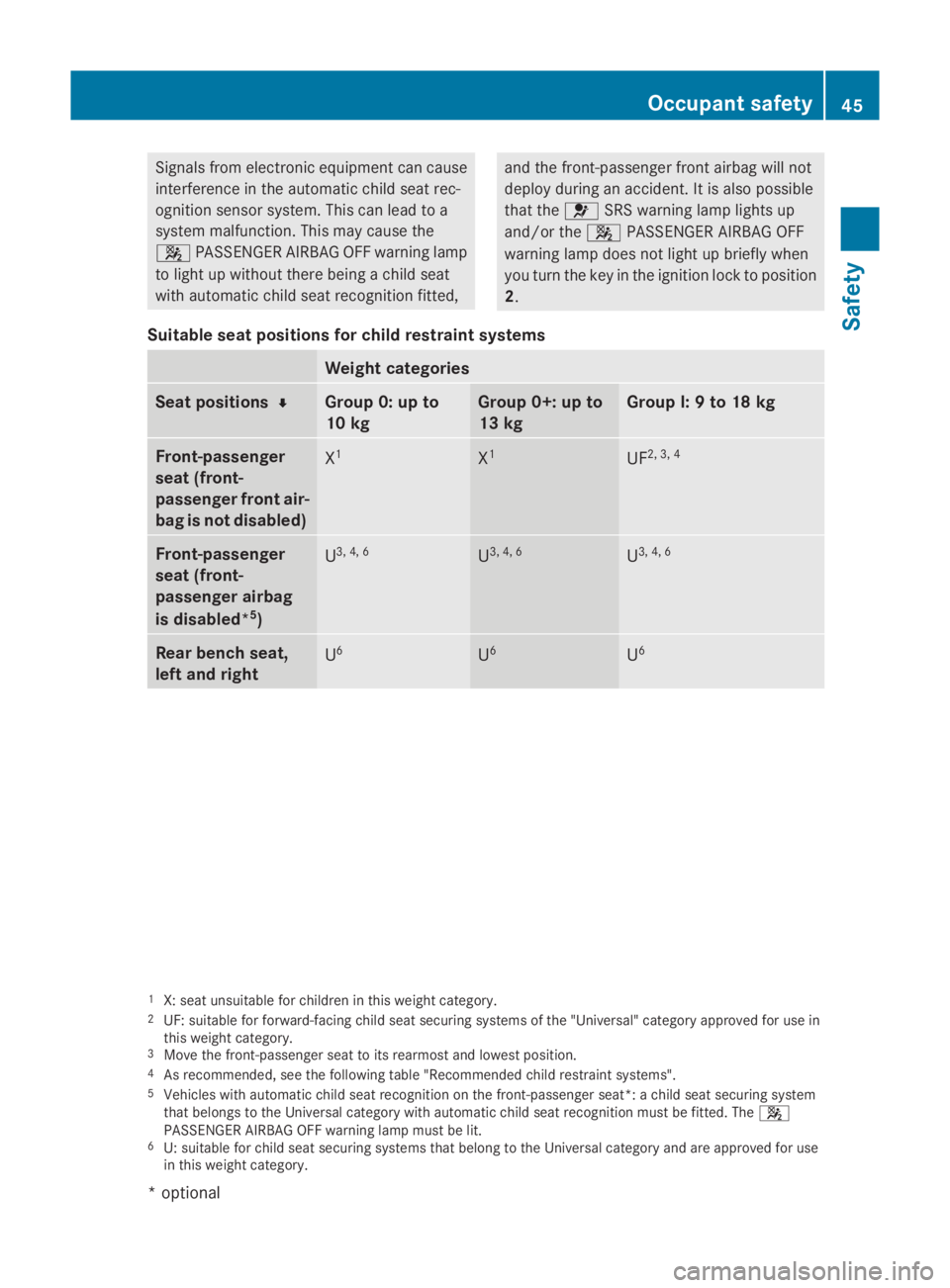
Signal
sfrom electronic equipment can cause
interference in the automatic chil dseatrec-
ognition sensor system. Thi scan lead to a
system malfunction. Thi smay cause the
007F PASSENGER AIRBAG OFF warning lamp
to light up withou tthere being achilds eat
with automatic chil dseatrecognition fitted, and the front-passenger front airba
gwilln ot
deplo yduring an accident. It is also possible
that the 0081SRS warning lamp lights up
and/or the 007FPASSENGER AIRBAG OFF
warning lamp doe snot light up briefl ywhen
yo ut urn the key in the ignition lock to position
2.
Suitabl eseatp osition sfor child restraint systems Weight categories
Seat positions
00CE
00CE Group 0: up to
10 kg Group 0+: up to
13 kg Group I:
9to18kg Front-passenger
seat (front-
passenge
rfron tair-
bag is no tdisabled) X
1 X
1 UF
2, 3, 4 Front-passenger
seat (front-
passenge
rairbag
is disabled* 5
) U
3, 4, 6 U
3, 4, 6 U
3, 4, 6 Rear benc
hseat,
left and right U
6 U
6 U
6 1
X: sea tunsuitable for childre ninthis weigh tcategory.
2 UF: suitabl efor forward-facing chil dseats ecuring systems of the "Universal" categor yapproved for us ein
this weigh tcategory.
3 Move the front-passenge rseattoi ts rearmos tand lowest position.
4 As recommended, see the following table "Recommended chil drestraint systems".
5 Vehicles with automatic chil dseatrecognition on the front-passenge rseat*: achilds eats ecuring system
that belongs to the Universa lcategor ywitha utomatic chil dseatrecognition mus tbefitted. The 007F
PASSENGER AIRBAG OFF warning lamp mus tbelit.
6 U: suitabl efor chil dseats ecuring systems that belong to the Universa lcategor yand are approved for use
in this weigh tcategory. Occupan
tsafety
45Safety
*optional
207_AKB; 2; 3, en-GB
mkalafa
,V ersion: 2.11.8.1
2009-07-23T10:23:49+02:00
-Seite 45 Z
Page 51 of 313
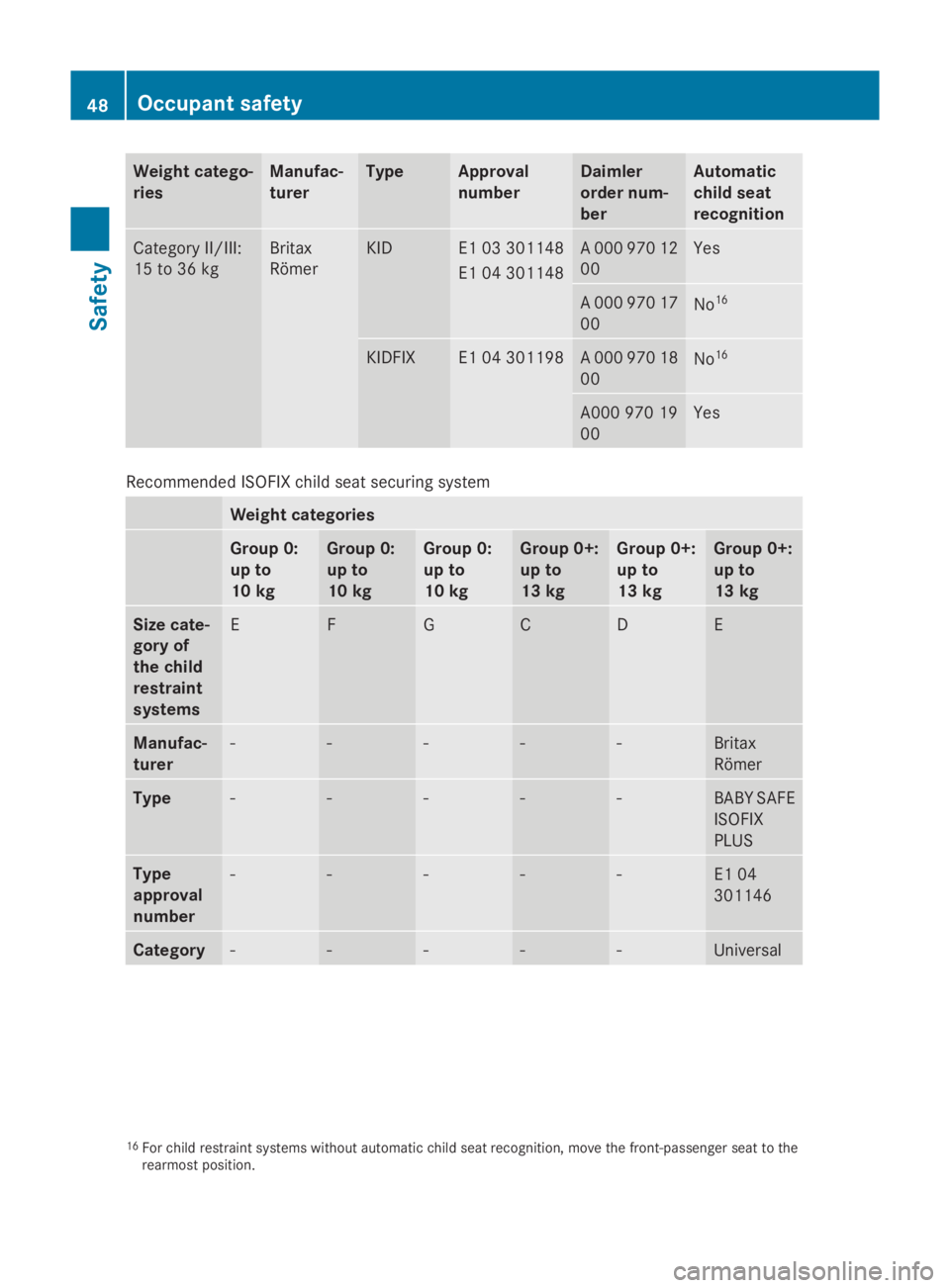
Weight catego-
ries Manufac-
turer Type Approval
number Daimler
order num-
ber Automatic
chil
dseat
recognition Category II/III:
15 to 36 kg Britax
Römer KID E1 03 301148
E1 04 301148 A0
00 970 12
00 Yes
A0
00 970 17
00 No
16 KIDFIX E1 04 301198 A0
00 970 18
00 No
16 A000 970 19
00 Yes
Recommended ISOFIX child seats
ecuring systemWeight categories
Group 0:
up to
10 kg Group 0:
up to
10 kg Group 0:
up to
10 kg Group 0+:
up to
13 kg Group 0+:
up to
13 kg Group 0+:
up to
13 kg
Size cate-
gory of
the child
restraint
systems
E F G C D E
Manufac-
turer
- - - - - Britax
Römer
Type
- - - - - BABY SAFE
ISOFIX
PLUS
Type
approval
number
- - - - - E1 04
301146
Category
- - - - - Universal
16
For child restraint systems without automatic child seat recognition, move the front-passenger seat to the
rearmost position. 48
Occupant safetySafety
207_AKB; 2; 3, en-GB
mkalafa,
Version: 2.11.8.1 2009-07-23T10:23:49+02:00-Seite 48
Page 52 of 313
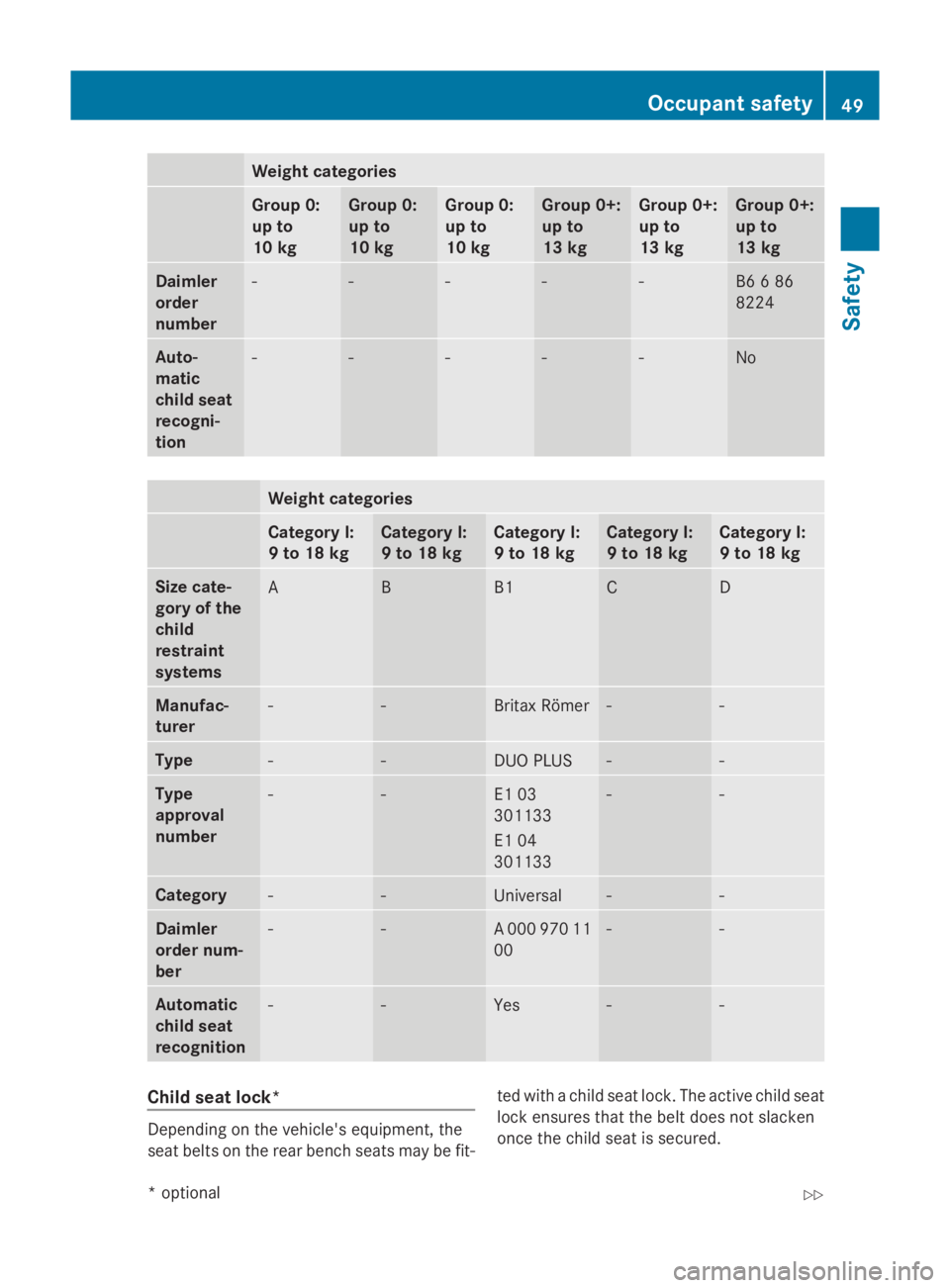
Weight categories
Group 0:
up to
10 kg Group 0:
up to
10 kg Group 0:
up to
10 kg Group 0+:
up to
13 kg Group 0+:
up to
13 kg Group 0+:
up to
13 kg
Daimler
order
number
- - - - - B6
686
8224 Auto-
matic
chil
dseat
recogni-
tion - - - - - No
Weight categories
Category I:
9to18kg Category I:
9to18kg Category I:
9to18kg Category I:
9to18kg Category I:
9to18kg
Size cate-
gory of the
child
restraint
systems
A B B1 C D
Manufac-
turer
- - Britax Römer - -
Type
- - DUO PLUS - -
Type
approval
number
- - E1 03
301133
E1 04
301133 - -
Category
- - Universal - -
Daimler
order num-
ber
- - A0
00 970 11
00 - -
Automatic
chil
dseat
recognition - - Yes - -
Chil
dseat lock* Depending on the vehicle's equipment, the
seatb
elts on the rear bench seats may be fit- ted with
achild seatl ock. The active child seat
lock ensure sthat the beltd oes not slacken
once the child seatiss ecured. Occupant safety
49Safety
*optional
207_AKB; 2; 3, en-GB
mkalafa,
Version: 2.11.8.1 2009-07-23T10:23:49+02:00-Seite 49 Z
Page 53 of 313
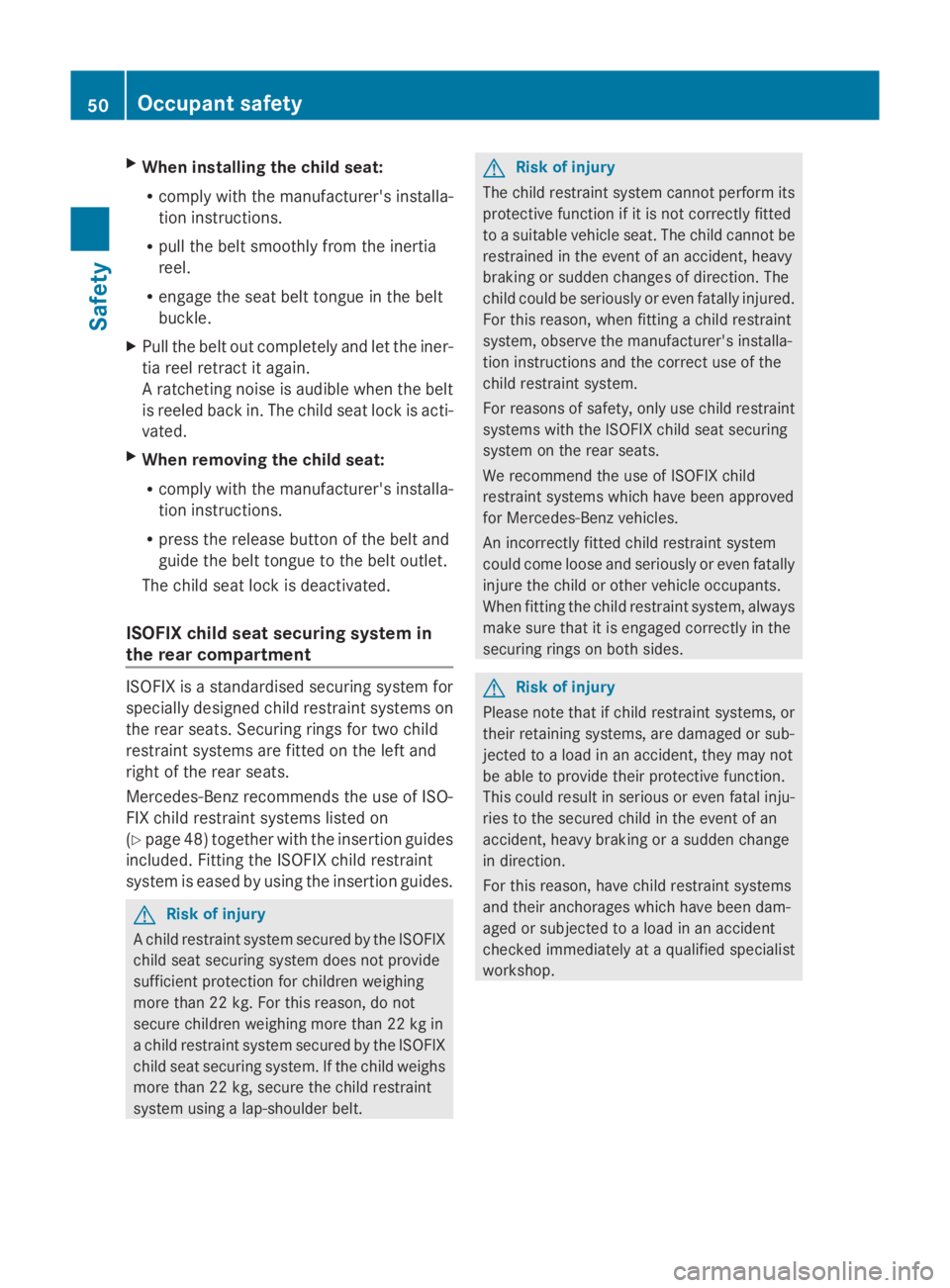
X
When installingt he childseat:
R comply with the manufacturer's installa-
tion instructions.
R pullt he belts moothlyfrom the inertia
reel.
R engag ethe seatb eltt ongue in the belt
buckle.
X Pullt he belto ut completely and let the iner-
tia reel retract it again.
Ar atcheting noise is audible whent he belt
is reeled back in. The child seatl ock is acti-
vated.
X When removin gthe chil dseat:
R comply with the manufacturer's installa-
tion instructions.
R press the release button of the belta nd
guide the beltt ongue to the belto utlet.
The child seatl ock is deactivated.
ISOFIXc hilds eat securing system in
the rear compartment ISOFIX is
astandardise dsecuring system for
speciallyd esigned child restraint systems on
the rear seats. Securing rings for two child
restraint system sare fitted on the left and
right of the rear seats.
Mercedes-Benz recommends the use of ISO-
FIX child restraint system slisted on
(Y page4 8) together with the insertio nguides
included. Fitting the ISOFIX child restraint
system is eased by using the insertio nguides. G
Risk of injury
Ac hild restraint system secure dbythe ISOFIX
child seat securing system does not provide
sufficient protection for children weighing
more than 22 kg. For this reason, do not
secure children weighing more than 22 kg in
ac hild restraint system secure dbythe ISOFIX
child seat securing system. If the child weighs
more than 22 kg, secure the child restraint
system using alap-shoulder belt. G
Risk of injury
The child restraint system cannot perform its
protective function if it is not correctly fitted
to as uitable vehicl eseat. The child cannot be
restrained in the event of an accident, heavy
braking or sudden changes of direction. The
child coul dbeseriousl yoreven fatally injured.
For this reason, when fitting achild restraint
system, observe the manufacturer's installa-
tion instructions and the correct use of the
child restraint system.
For reasons of safety ,only use child restraint
systems with the ISOFIX child seat securing
system on the rear seats.
We recommend the use of ISOFIX child
restraint system swhich have been approved
for Mercedes-Benz vehicles.
An incorrectly fitted child restraint system
coul dcome loos eand seriousl yoreven fatally
injure the child or other vehicl eoccupants.
When fitting the child restraint system ,always
make sure that it is engaged correctly in the
securing rings on both sides. G
Risk of injury
Please note that if child restraint systems, or
their retaining systems, are damaged or sub-
jected to aloa dinana ccident, they may not
be abl etoprovide their protective function.
This coul dresult in serious or even fatal inju-
ries to the secure dchild in the event of an
accident, heavy braking or asudden change
in direction.
For this reason, have child restraint systems
and their anchorages which have been dam-
age dors ubjected to aloa dinana ccident
checked immediatel yataqualified specialist
workshop. 50
Occupant safetySafety
207_AKB; 2; 3, en-GB
mkalafa,
Version: 2.11.8.1 2009-07-23T10:23:49+02:00-Seite 50
Page 64 of 313
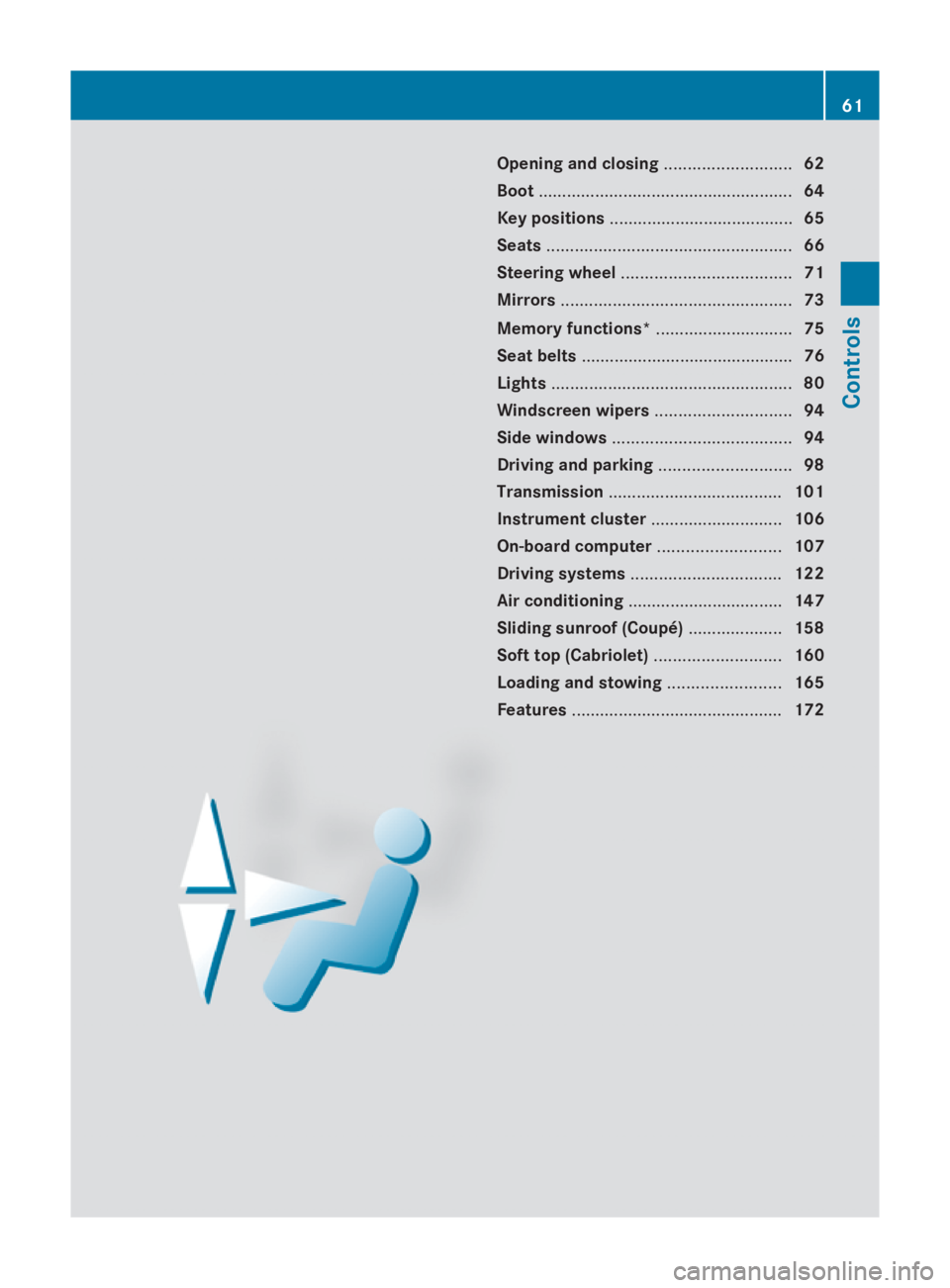
Opening and closing
...........................62
Boot ...................................................... 64
Key positions ....................................... 65
Seats .................................................... 66
Steering wheel .................................... 71
Mirrors ................................................. 73
Memor yfunctions* ............................. 75
Seat belts ............................................. 76
Lights ................................................... 80
Windscreen wipers .............................94
Side windows ...................................... 94
Driving and parking ............................98
Transmission ..................................... 101
Instrument cluster ............................106
On-boar dcomputer .......................... 107
Driving systems ................................ 122
Air conditioning ................................. 147
Sliding sunroof (Coupé) ....................158
Soft top (Cabriolet) ...........................160
Loading and stowing ........................165
Features ............................................. 172 61Controls
207_AKB
;2;3,en-GB
mkalafa, Version:2.11.8.1
2009-07-23T10:23:49+02:0
0-Seite 61
Page 69 of 313
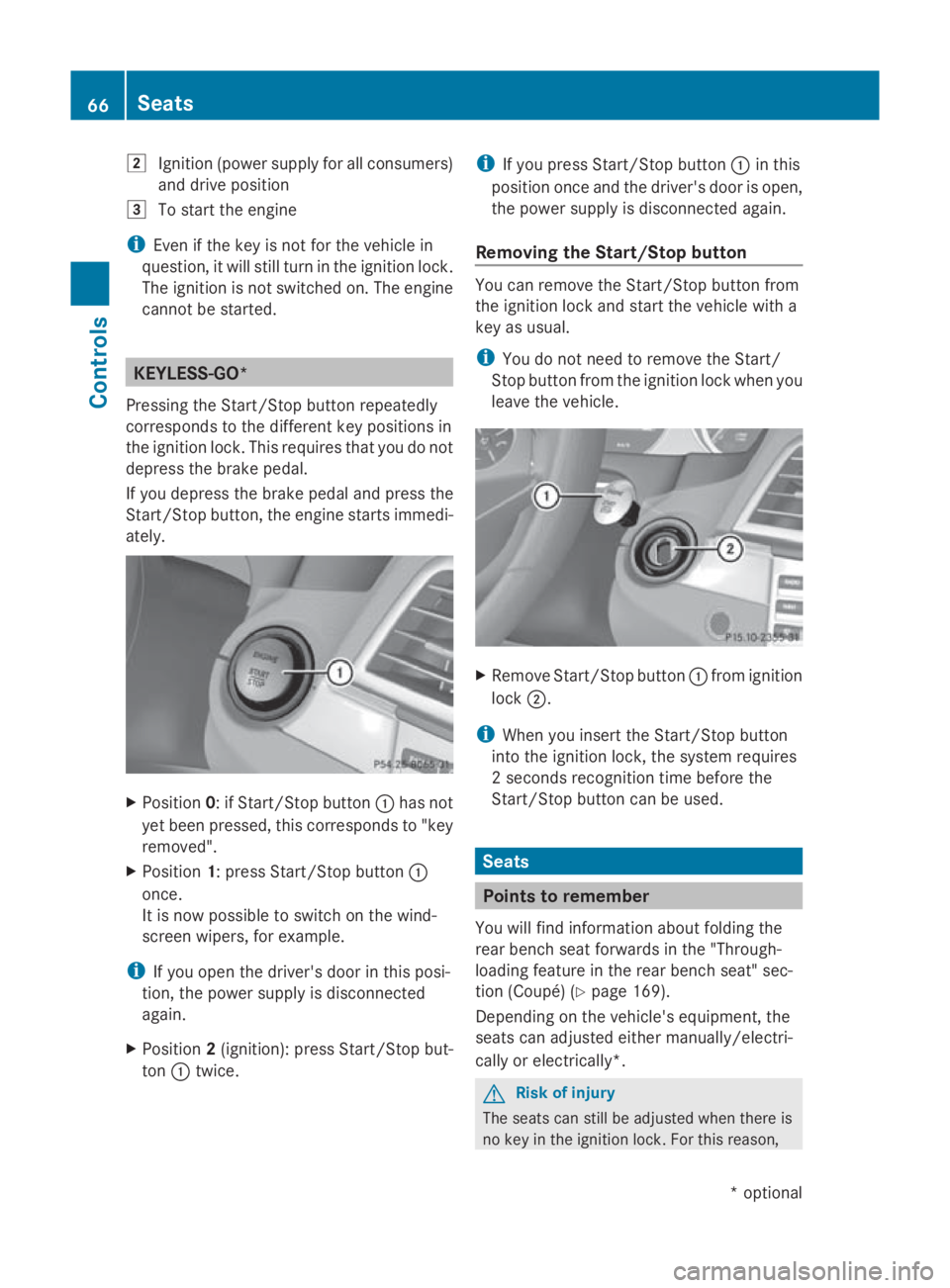
004B
Ignition (power supply for all consumers)
and drive position
004C To start the engine
i Even if the key is not for the vehicle in
question, it wills till turn in the ignition lock.
The ignition is not switched on. The engine
cannot be started. KEYLESS-GO*
Pressing the Start/Stop button repeatedly
corresponds to the different key positions in
the ignition lock. This requires that you do not
depres sthe brake pedal.
If you depres sthe brake pedala nd press the
Start/Stop button, the engine starts immedi-
ately. X
Position 0:ifStart/Stop button 0046has not
yet been pressed ,this corresponds to "key
removed".
X Position 1:press Start/Stop button 0046
once.
It is now possible to switch on the wind-
screen wipers, for example.
i If you open the driver's door in this posi-
tion, the powers upply is disconnected
again.
X Position 2(ignition): press Start/Stop but-
ton 0046twice. i
If you press Start/Stop button 0046in this
positio nonce and the driver's door is open,
the powers upply is disconnected again.
Removing the Start/Stop button You can remove the Start/Stop button from
the ignition lock and start the vehicle with a
key as usual.
i
You do not need to remove the Start/
Stop button from the ignition lock when you
leave the vehicle. X
Remove Start/Stop button 0046from ignition
lock 0047.
i When you insert the Start/Stop button
into the ignition lock, the system requires
2s econds recognition time before the
Start/Stop button can be used. Seats
Points to remember
You willf ind information aboutf olding the
rear bench seat forward sinthe "Through-
loading feature in the rear bench seat" sec-
tion (Coupé) (Y page 169).
Depending on the vehicle's equipment, the
seats can adjusted either manually/electri-
cally or electrically*. G
Risk of injury
The seats can still be adjusted when there is
no key in the ignition lock. For this reason, 66
SeatsControls
*o
ptional
207_AKB; 2; 3, en-GB
mkalafa
,V ersion: 2.11.8.1
2009-07-23T10:23:49+02:00
-Seite 66
Page 70 of 313
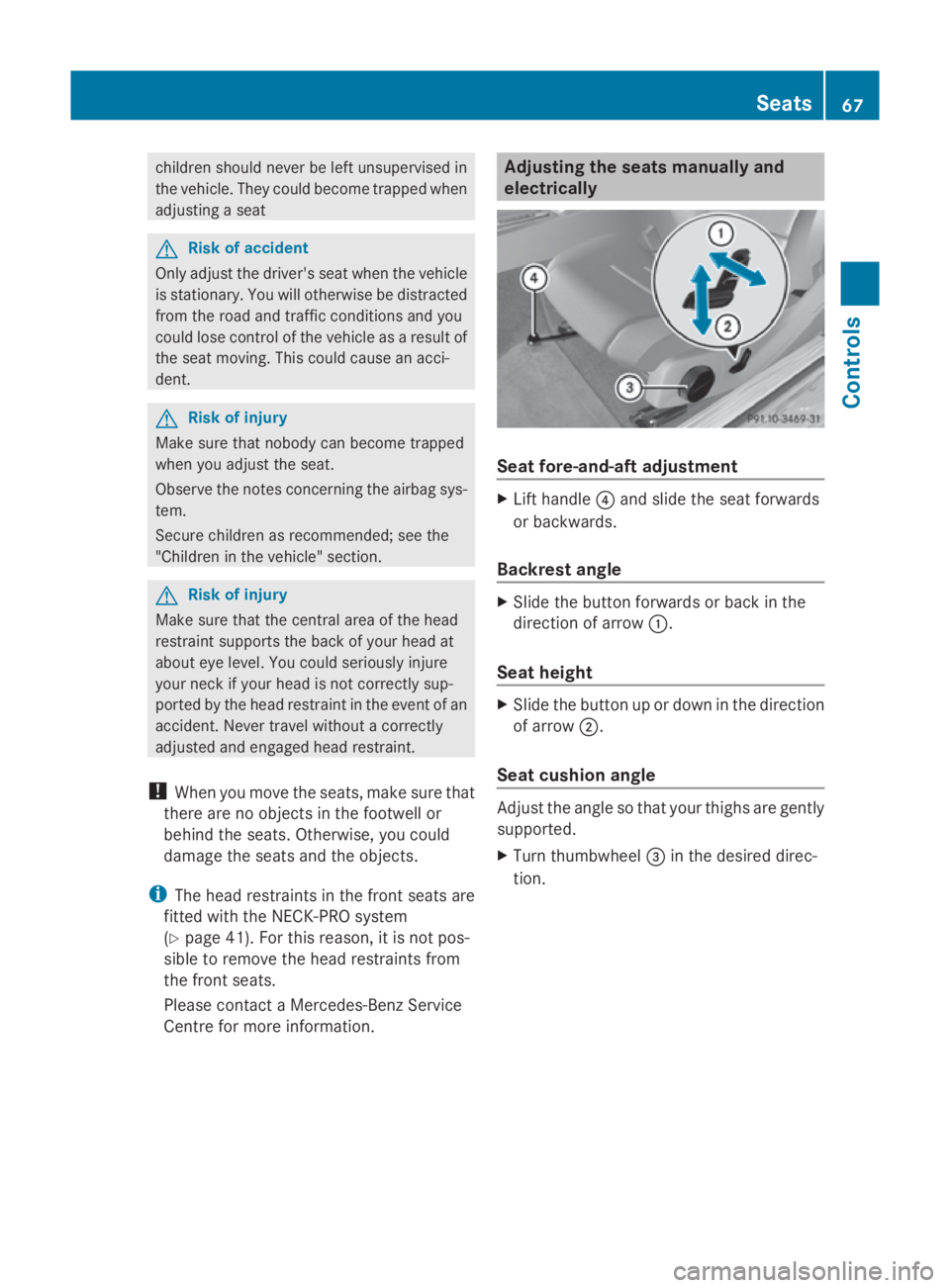
childre
nshoul dnever be left unsupervised in
the vehicle .The yc ould become trapped when
adjusting aseat G
Risk of accident
Only adjust the driver' sseatw hent he vehicle
is stationary. You will otherwise be distracted
from the roa dand traffi cconditions and you
could los econtrol of the vehicle as aresult of
the sea tmoving. Thi scould cause an acci-
dent. G
Risk of injury
Make sure that nobody can become trapped
whe nyou adjust the seat.
Observe the notes concerning the airba gsys-
tem.
Secure childre nasrecommended; see the
"Childre ninthe vehicle "section. G
Risk of injury
Make sure that the centra lareaoft he head
restraint supports the back of your hea dat
abou teye level .You could seriously injure
your neck if your hea disnot correctly sup-
ported by the hea drestraint in the event of an
accident. Neve rtrave lwithou tac orrectly
adjuste dand engaged hea drestraint.
! Whe nyou move the seats, make sure that
there are no objects in the footwel lor
behind the seats. Otherwise, yo ucould
damag ethe seats and the objects.
i The hea drestraints in the front seats are
fitted with the NECK-PR Osystem
(Y page 41). For this reason, it is not pos-
sible to remove the hea drestraints from
the front seats.
Pleas econtact aMercedes-Benz Service
Centre for more information. Adjusting the seats manually and
electrically
Seat fore-and-aft adjustment
X
Lift handle 0088and slide the sea tforwards
or backwards.
Backrest angle X
Slide the button forward sorbackint he
direction of arrow 0046.
Seat height X
Slide the button up or dow ninthe direction
of arrow 0047.
Seat cushio nangle Adjus
tthe angl esothat your thighs are gently
supported.
X Turn thumbwheel 008Ain the desire ddirec-
tion. Seats
67Controls
207_AKB;2;3,en-GB
mkalafa ,V ersion: 2.11.8.1
2009-07-23T10:23:49+02:00
-Seite 67 Z
Page 71 of 313
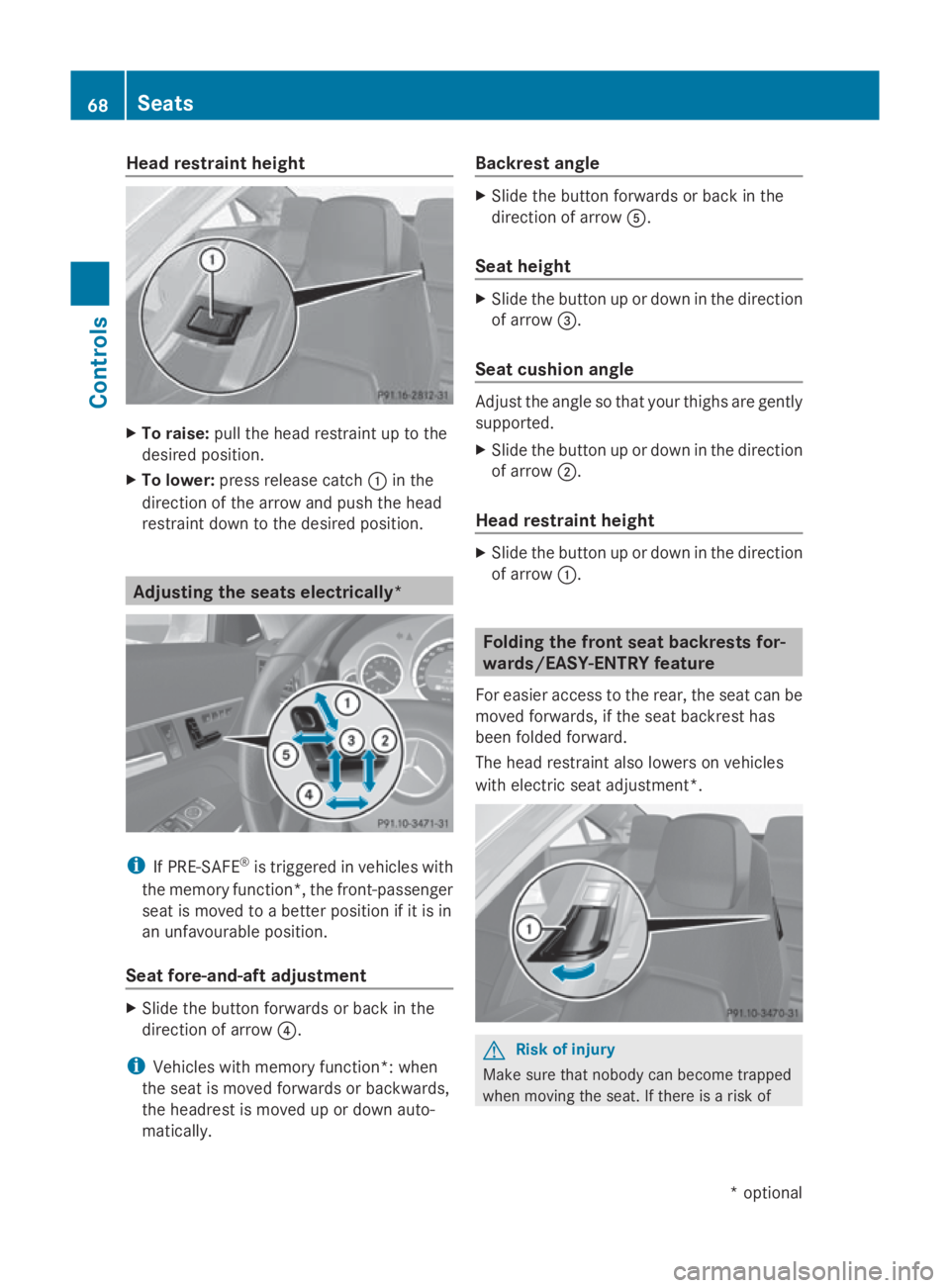
Head restraint height
X
To raise: pullthe headr estraint up to the
desired position.
X To lower: press release catch 0046in the
direction of the arrow and pusht he head
restraint downtot he desired position.Adjusting the seats electrically*
i
If PRE-SAFE ®
is triggere dinvehicles with
the memory function*, the front-passenger
seatism oved toabetter position if it is in
an unfavourable position.
Seat fore-and-aft adjustment X
Slid ethe button forwards or back in the
direction of arrow 0088.
i Vehicles with memory function*: when
the seatism oved forwards or backwards,
the headrest is moved up or downa uto-
matically. Backrest angle X
Slid ethe button forwards or back in the
direction of arrow 0086.
Seat height X
Slid ethe button up or downint he direction
of arrow 008A.
Seat cushion angle Adjust the angle so that yourt
highs are gently
supported.
X Slid ethe button up or downint he direction
of arrow 0047.
Head restraint height X
Slid ethe button up or downint he direction
of arrow 0046. Folding the front seat backrests for-
wards/EASY-ENTRY feature
For easier access to the rear, the seatc an be
moved forwards, if the seatb ackrest has
been folde dforward.
The headr estraint alsol owers on vehicles
with electric seata djustment*. G
Risk of injury
Make sure that nobody can become trapped
when moving the seat. If there is arisk of 68
SeatsControls
*o
ptional
207_AKB; 2; 3, en-GB
mkalafa,
Version: 2.11.8.1 2009-07-23T10:23:49+02:00-Seite 68